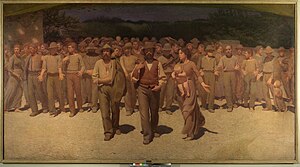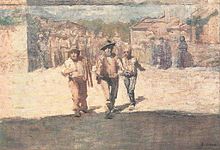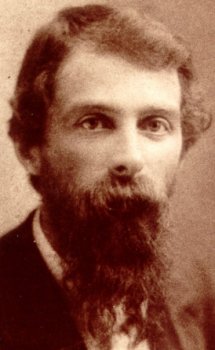The fourth stand

|
| Il Quarto Stato (The Fourth Stand) |
|---|
| Giuseppe Pellizza da Volpedo , 1901 |
| Oil on canvas |
| 293 × 545 cm |
| Museo del Novecento , Milan |
The fourth stand (Italian original: Il Quarto Stato ) is the title of the most famous painting by the Piedmontese artist Giuseppe Pellizza da Volpedo . After several years of preparatory work, it was started in 1898 and completed in 1901.
Pellizza da Volpedo processed the picture mainly in a divisionist painting technique . Although influenced by contemporary modern neo-impressionism , it is one of the most important works of late realism painting in Italy.
It is a monumental work of art on an area of almost 16 square meters (293 cm × 545 cm) painted with oil on canvas, dominated by "earthy" rusty-red-sand-colored tones , which shows a coming presence and strengthening of the labor movement at the beginning of the 20th century (symbolically transferred “... of a new age”) symbolically evokes and at the same time sets a monument to this movement that has an impact up to the present day.
Since December 2010, the original painting can be viewed in the Milan's Museum of the 20th Century ( Museo del Novecento ).
Preliminary work
The work on the final painting, which Pellizza da Volpedo initially turned to (in 1898) under the working title “The Workers' Way” (Italian: Il cammino dei lavoratori ), was preceded by a creative process lasting about seven years, during which he developed the theme “ Aufbruch der Arbeiterbewbewegung ”with different interim paintings, but similar motifs (for example “ Ambassadors of Hunger ” (1891/1892), “ Der Menschenstrom ” (1895/1896)) and the content becoming increasingly clearer (focused on the essentials). From version to version, buildings and parts of the landscape that are depicted are initially left out, whereas the people form the central motif more and more until they finally take up almost the entire surface of the picture.
The sketches and portraits he made over the years of farm workers in his Piedmontese hometown of Volpedo , from whose midst he came and whose concerns and socio-political demands he supported, provided him with the background for the design of the main work.
Motive and interpretation
The motif of Il Quarto Stato depicts a mass of farm workers emerging from the darkness into the light; a march of people of both sexes and almost every age, which seems to be marching frontally (also confrontationally ), demanding and self-confident (symbolically "from the shadow of the past and history into the enlightened present"). Its foremost lines take up the entire width of the painting. An end to the stream of people, which seems to extend as far as the horizon indicated in the darkness, cannot be made out.
In the center and foreground are three people depicted life-size in the original painting (two determined men and a Madonna- like woman with a male toddler in her arms , who is inspired by the High Renaissance painter Raphael and who appears to the side with plaintive facial expressions ) as prominent or leading individuals with individual features to recognize; whereas the individual people of the crowd immediately behind them often only appear vague - still hidden in the anonymity of the crowd , so to speak, and merging with it.
The cultural scientist , columnist and author Georg Seeßlen wrote in 2006 about Il Quarto Stato in CompareAdded context to other works of art on the subject of "work" as comments on the relationship between work and modern art under the title "Work makes art" for the cultural section of the weekly newspaper of Friday (excerpt):
- “[…] The worker as a rebel , as in the famous picture by Giuseppe Pellizza da Volpedo, the 1901 Il Quarto Stato, the fourth estate in earthy colors in the heroic march towards the viewer, arises as a bourgeois myth . Pellizza da Volpedo raved about the 'suffering and beauty' of the workers and showed the stooped figures of the exploited in front of the bridge that only allows goods to cross between the have and the not-have . It is humanistic realism that begins a narrative of the working class, against the disappearance in the dominant culture , whose project seems to consistently fade out work, until the television program last night.
- Twenty years earlier, Vincent van Gogh had shown his husband at the loom or his couple working in the fields with stoic equanimity; Pellizza da Volpedo's workers, on the other hand, are already on the verge of despair; only their uprising can save them; their pride lies only in revolt , not in work. At the same time, photographers in the USA are already looking into sweat shops and ghetto economies. A form of organized poverty in endless work emerges, the exact opposite of the happy workers on the scaffolding of the high-rise buildings, who were soon to give an 'official' picture of the work. [...] "
Place of issue
At an exhibition that opened in Milan in 1902, Pellizza da Volpedo presented his painting to the general public for the first time. It was the city of Milan that bought the painting in 1920 from the heirs of the artist who died in 1907 through suicide . For a long time it was housed in the local gallery for modern art ( Galleria d'Arte Moderna ).
At present, “Il Quarto Stato” is the exhibit at the Museo del Novecento (“Museum of the 20th Century”), a museum for contemporary art that opened on December 6, 2010 in the Palazzo dell'Arengario in the northern Italian metropolis .
A previous painting - “La Fiumana” ( The Stream of People ) - is also on display in Milan, but in the Pinacoteca di Brera , a museum of ancient and modern art. Other previous designs are mostly part of private collections .
Post-operative reception and additional dissemination
The Italian director Bernardo Bertolucci used the painting in the opening credits of his two-part Monumental feature film 1900 (Italian: Novecento ) produced in 1976 , accompanied by the supporting film music composed by Ennio Morricone under the title Romanzo .
Bertolucci's internationally successful cinema production gave “Il Quarto Stato” additional popularity . The production of poster reprints of the painting - in relation to the original with a significantly smaller format - increased. In this way, the picture was widespread as wall decoration in numerous households, especially in the left and alternative scene , especially during the 1970s and 1980s .
In 1972, four years before Bertolucci, it was the style-defining action artist Joseph Beuys who, in his self-staging "La rivoluzione siamo Noi" ( We are the revolution ) taken by the photographer Giancarlo Pancaldi, resorted to the motif of "Il Quarto Stato" by using the The pose of the central male figure in the middle of the painting - marching towards the viewer with a determined expression - was photographed. With the sentence "We are the revolution" Beuys placed a political and social commitment in connection with his artistic work. With this he intended to renew and propagate a traditional connection between revolution and artistic avant-garde .

In 2003, the director and author Emilio Mandarino shot the half-hour short film "Il Quarto Stato" for Italian television. In this documentary portrait of Giuseppe Pellizza da Volpedo and his main work, the development of the picture and the artist's creative process from the first sketches in 1891 to the final painting in 1901 are traced and dramaturgically processed.
There are many other adaptations of the image in association with the original work, often with an alienated motif and related to different cultural, political or historical contexts. They range from advertising graphics to election posters to cartoons and caricatures . More recently, the Italian left-wing alliance Rivoluzione Civile , which, under the leadership of Antonio Ingroia , united communist, left-social-democratic, green and left-liberal parties on the occasion of the 2013 election of the Italian parliament , has also chosen a stylized version of the work as its symbol.
literature
- Labor, art and mass media: Giuseppe Pellizza's "Il Quarto Stato" and the illustrated press. In: Martina Hansmann and Max Seidel (eds.): Pittura italiana nell'Ottocento. Marsilio, Venice 2005, pp. 331-348.
- Gabriele Mucchi: “The fourth stand”. To a painting by G. Pellizza. In: Fine Arts , 5th year, 1957, pp. 177–178.
- Aurora Scotti: Pellizza da Volpedo. Catalogo generale. Milan 1986.
Web links
- " The fourth stand " in the archive of pictures of work (bilder-der-arbeit.de) (thumbnail third row, fourth picture from the left click to enlarge and for further information)
- Italian web portal on Giuseppe Pellizza da Volpedo with various links to the life, work and impact of the artist (left column) , including a link to the aftermath of the picture Il quarto Stato (sixth link: "La" Fortuna "del Quarto Stato" with texts, Articles, cartoons and other adaptations as well as alienation of the motif in association with other cultural or historical contexts); Page in Italian
- La forza di un'immagine (The power of an image) ; Presentation in the form of a series of images of various adaptations, graphic alienations in photographs, cartoons, posters or collages with different political interpretations of the original painting Il quarto stato on youtube.com (approx. 4½ minutes)
Notes / individual evidence
- ↑ Il cammino dei lavoratori ; Illustration of the first working template of the final painting from 1898 ( Memento of the original from October 22, 2011 in the Internet Archive ) Info: The archive link was inserted automatically and has not yet been checked. Please check the original and archive link according to the instructions and then remove this notice.
- ↑ Illustrations of the individual stages of development, drafts and interim paintings between 1891 and 1901: From “Ambasciatori della fame” ( Ambassador of Hunger ) to “Il Quarto Stato” ( The fourth stand ) on www.pellizza.it ( Memento of the original from September 24th 2011 in the Internet Archive ) Info: The archive link was inserted automatically and has not yet been checked. Please check the original and archive link according to the instructions and then remove this notice. Click on the images to enlarge them
- ↑ quoted from Georg Seeßlen: Work makes art - Notes on the relationship between work and modern art ( Friday , August 25, 2006)
- ^ Feature Deutschlandfunk: "Hunger nach Kultur" , contribution by Henning Klüver on January 5, 2011 on the opening of the Museo del Novecento
- ↑ Intromusic of the film "1900" using the painting Il Quarto stato on youtube.com
- ^ Oskar Bätschmann : Shooting Stars , pp. 20/21 ( Memento from June 10, 2015 in the Internet Archive )
- ^ Description of the short film "Il Quarto Stato" by Emilio Mandarino, on fctp.it (Film Commission Torino Piemonte) , Italian




